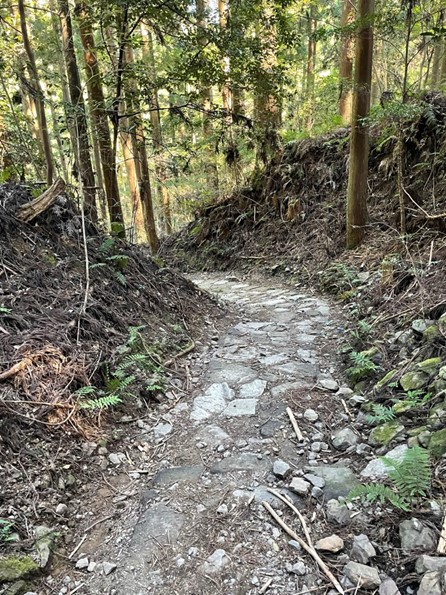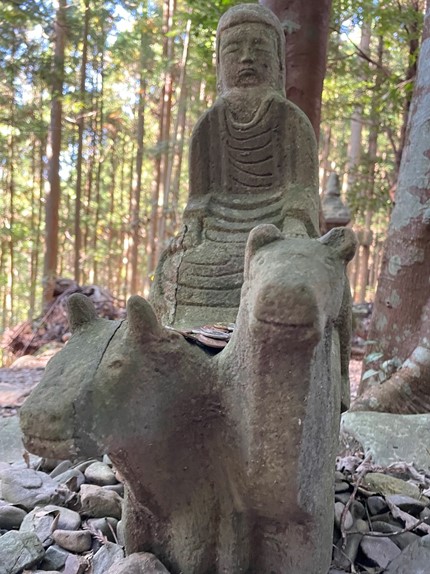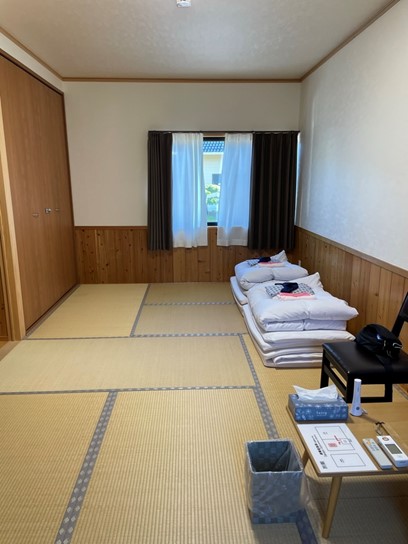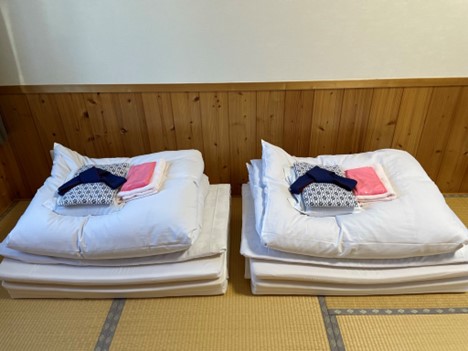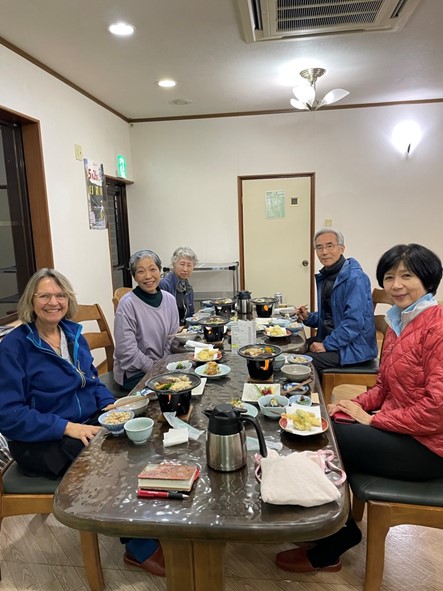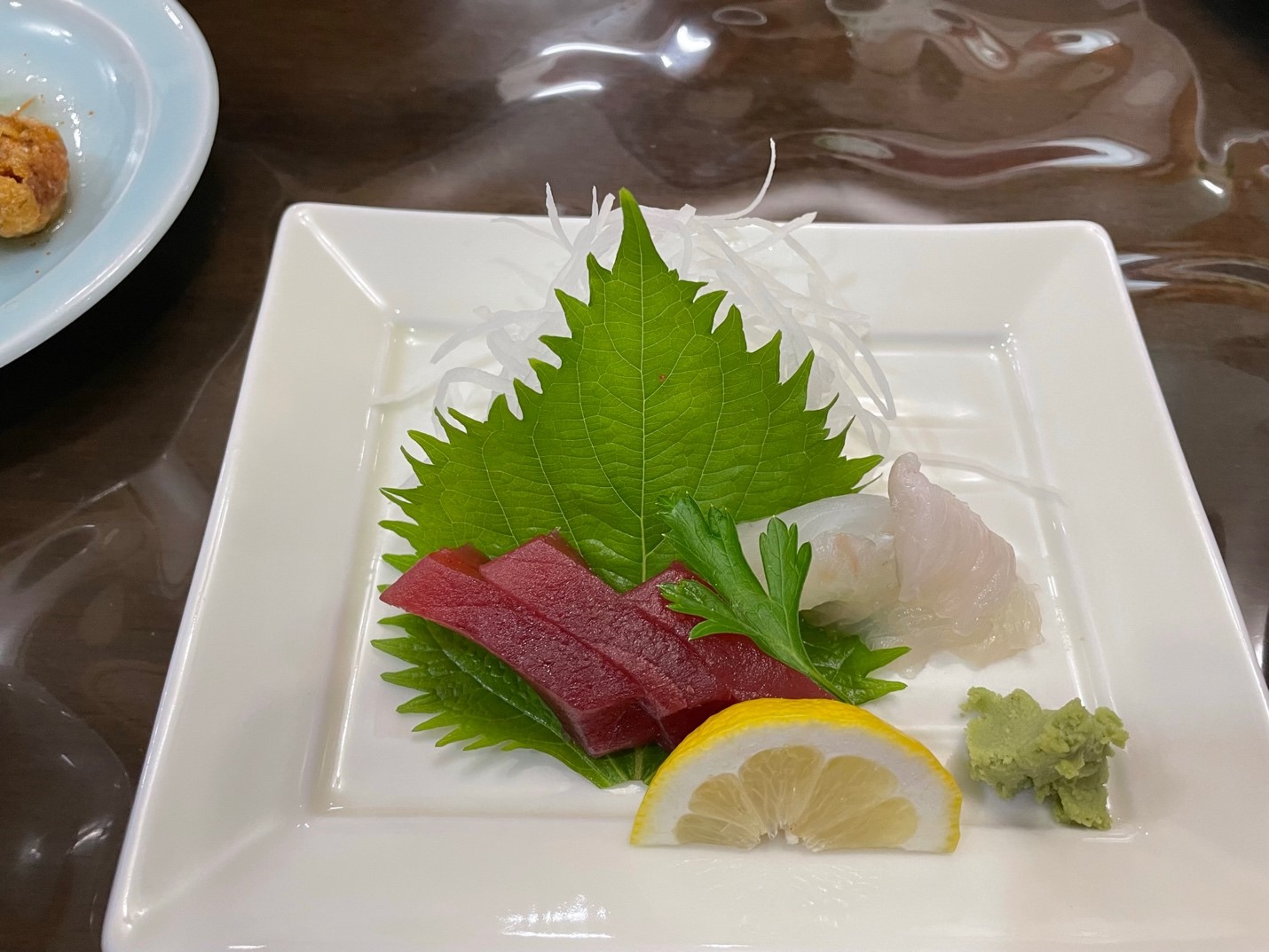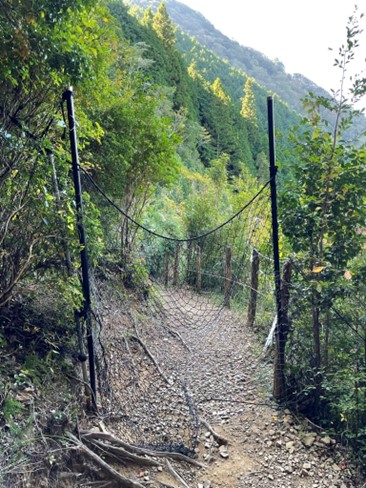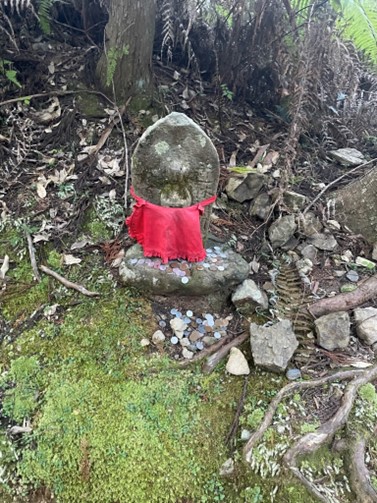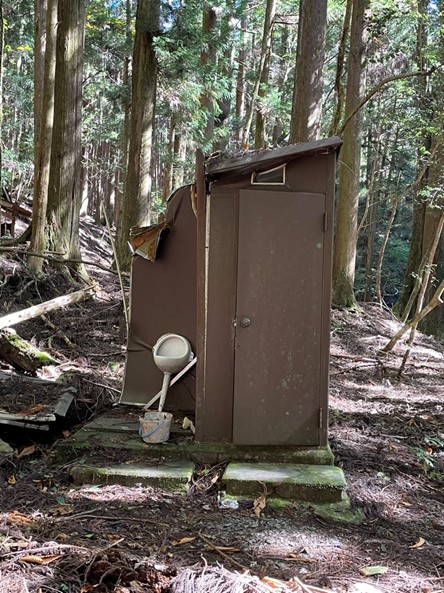The next two days of hiking
My friend Yuko had planned the pilgrimage in a very detailed way. We only had to carry what we needed for the day. Also, there was always a car available – either her friend Yae-san (who lives in Takahara) picked us up or brought us to the section we stopped the day before, or Yuko used her own car for transportation. Also, all the accommodations were reserved in advance (very necessary because accommodations along the way are limited) and the places we stayed were always very nice. This was a “luxury pilgrimage” for me.
.
.
.
.
.
A typical path on the Nakahechi route is in a cedar forest. The Kumano area is called “land of trees and endless mountains”. Except in shrines or temples, I hardly ever saw very old trees along the path. One of the major reasons was World War II when towns burned down and had to be rebuild. Native trees were used and replaced by fast growing trees like Japanese cedars and cypresses. Trees were also planted on rice fields, as the government paid the people for each tree planted. Walls of stones in the middle of the forest point to the past.
.
.
.
.
Stone walls of past rice fields, useless in a forest
.
.
.
.
.
Along the way, there were many little shrines and historical places. Sometimes, only signs pointed to the former significance of the place. For example, many teahouses invited pilgrims for a rest, but all are gone.
.
.
.
.
.
Sometimes stone walls lined our way – they are called “wild boar fences” – and were built in former times to keep wild boars and deer out of villages and fields.
.
.
.
. We were lucky to have magnificent hiking weather
.
.
.
.
Sometimes the path was paved – I prefer to hike on uneven ground
.
.
.
.
.
A collection of statues on a mountain pass refers to past times. The statue with the sword is the legendary founder of Shugendo, Ennogyoja (an ascetic mountain practice).
.
.
.
.
.
Retired emperor Kazan (10th century) as a boy riding on a horse and a cow. He was one of the first emperors making an Imperial pilgrimage to Kumano.
.
.
.
.
Another station for a stamp
.
.
We stayed overnight in the Minshuku (Folk Inn, privately run inn) Chikatsuyu, consisting of several buildings – the building where we slept, kitchen with dining room and the onsen (hot bath). I changed slippers three times – outside of the house, inside of the house, in the bathroom another pair of slippers and no slippers in the tatami room where we slept – so Japanese!
.
.
.
。
Typical tatami room with two beds
.
,
.
.
.
Everything was beautifully arranged and provided – a yukata for the bath and sleeping, towels for onsen and like always, a toothbrush with a little toothpaste for the night.
.
.
.
..
View from the dining room
.
..
.
.
.
Dinner with Yae-san beside me, who was so helpful for us. The dinner was delicious and beautifully prepared – very Japanese!
.
.
.
.
Sashimi
.
.
.
Ingredients for a dish cooked at the table
/
.
The walk to Kumano-Hongu Taisha was longer than everybody wanted to walk the next day. Yuko brought me to an entrance path, from where I could connect with the official pilgrimage route. The rest of the group decided to go by car to the Grand Shrine and take a bus back to Hosshinmon Oji ,where we all would meet and walk the last stretch together.
.
.
.
When hiking up this narrow mountain path, I enjoyed the solitude and stillness. Only some birds were chirping. I heard my steps and my breath and again started to compose haikus in my head in order to capture the moment. Suddenly, I came to a high fence – the path was closed. I was shocked – did I take a wrong turn?
.
.
.
.
.
This fence was too high to climb over and also not strong enough. I was confused – why was the path closed? I stood there for a while not knowing what to do when suddenly, an idea came in my mind – maybe, I can lift the net up? This worked! I still do not know the reason for this net. Maybe, it has to do with the detour caused by a massive landslide on the main path. I continued to walk down the mountain and connected with the official pilgrimage route.
.
.
.
.
A jizo (kṣitigarbha: earth-womb bodhisattva) beside the path
.
.
,
Most of the toilets were more inviting than this one. On Japanese hiking trails, you always can find a toilet at certain distances.
.
.
.
.\
The Otonashi-gawa (Soundless-river)
.
Many of the rivers I saw in Japan are contained by high, man-made walls. The Japanese live with a lot of natural disasters and want to limit the damage. I can understand that. But I always felt sad that the beauty of a natural flow of water, which especially is benefitting animals and plants, is gone.
.
.
.
.
Yukawa-Oji with the torii
/
/
/
.
The dragon for purification – without water, he lost his purpose….
.
.
.
.
Funatama-jinja, in former times especially visited by fishermen. The shrine is connected with an ancient legend: One day, the deity Susanoo was standing under a waterfall nearby and took a bath. He saw a spider falling into the water, struggling not do drown. It found safety on a floating leaf. The deity was so touched that it inspired her to create the very first boat.
.
.
.
.
One of two foxes guarding the Inari-jinja with a wish full-filling jewel
in his mouth representing spiritual and material wealth.
.
.
.
.
.
I met Yuko, Shigeo and Hiroko-san at the Hosshinmon-oji, also know as “gate of awakening”. It marks the start of the sacred path to the Kumano-Hongu-Taisha. There once stood nearby a gate for pilgrims to walk through. By doing that, they symbolically died and were reborn into the Kumano Pure Land’s Paradise, a confirmation of salvation after death.
.
.
.
.
Lining up for a stamp near the Oji
.
.
.
.
.
It is only a 7km long hike to the Grand shrine. Sometimes, it felt like a stroll through a beautiful park.
.
.
.
..
.
We passed tea plantations, bamboo groves and often had a spectacular views to endless, green mountains.
.
.
.
.
Passing orchards of persimmon trees
.
.
.
Spectacular views to the endless mountain range
.
.
.
.
Bathing in the evening sun
.
.
.
/
A happy group
.
.
.
..
.
.
When we came closer to the Grand shrine, the roots of the cedar trees looked like little dragons crawling along the path.
.
.
.
.
.
Haraido-oji. This shrine was the most important shrine before entering the Hongu-Taisha. The final purification rites were performed in this place. “Harai” means exorcism or purification.
.
.
.
.
.
In the evening, we entered the area of the Grand Shrine. We did not have much time for a visit, but came back twice the next day.
.
.
.






